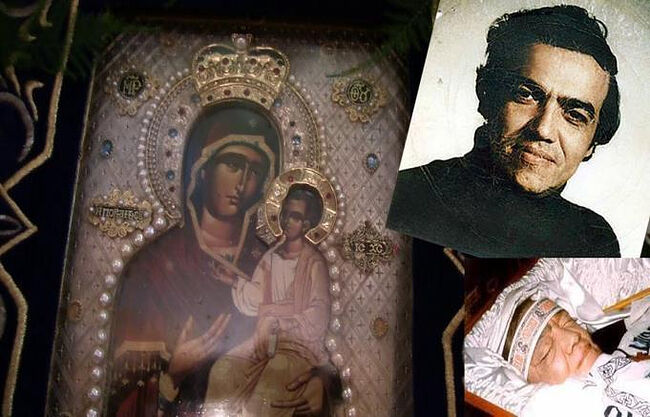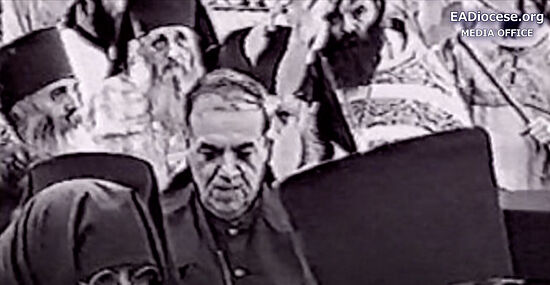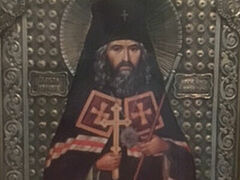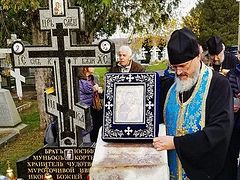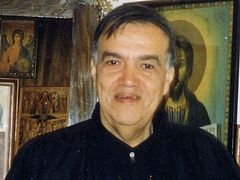The twenty-third annual pilgrimage by the parishioners of St. John the Baptist Cathedral in Washington, DC to Holy Trinity Monastery in Jordanville on October 30-31 was held in the spirit of grateful prayer to God.
A week before the pilgrimage, the Holy Protection Sisterhood of our capital-city parish began to prepare a large stock of food to treat all the pilgrims, brethren of the monastery and students of Holy Trinity Seminary. So much food was prepared that it was enough for several more monastery meals. This procedure has existed since the time of the ever-memorable Metropolitan Laurus, who asked us to bring food to the monastery in order to remember Brother Jose and at the same time, to lighten the burden of the monastery brethren. We are happy to fulfill the wish of our dear Metropolitan Laurus.
Pilgrims from Washington embarked on the seven-hour journey on Saturday, October 30 at 6 a.m. On the way, Morning Prayers were read and a conversation was held about the meaning of Jose Muñoz-Cortes, the keeper of the myrrh-streaming “Montreal” Iveron Icon of the Mother of God, for ROCOR and world Orthodoxy; a film was shown about the life and exploits of the chosen one of the Mother of God, martyred in 1997.
This year, our pilgrimage group was joined by people who had never been to Jordanville before and had little knowledge of Brother Jose’s life story. Many asked what led to the murder of Brother Jose and the concealment of the Holy Icon from us?
I always explain to those asking, that this question was answered by the archpastors of ROCOR in 2002 in a special Epistle on the occasion of the twentieth Anniversary of the Miraculous Myrrh Streaming Montreal-Iveron Icon of the Mother of God. This icon, pouring out abundant miraculous myrrh, has comforted our Russian Church Abroad for fifteen years, being a visible and tangible sign of the merciful intercession of the Mother of God for us sinners... Have we acted appropriately when an obvious wonderworking icon was present in our Church? Have we used this visit of our Lord’s Mother for the benefit of the soul, and not our common sin of weakening in our prayer to the icon, to works of piety and testimony of the Orthodox faith that became the reason for the removal by the scourge of God of the Holy Icon?
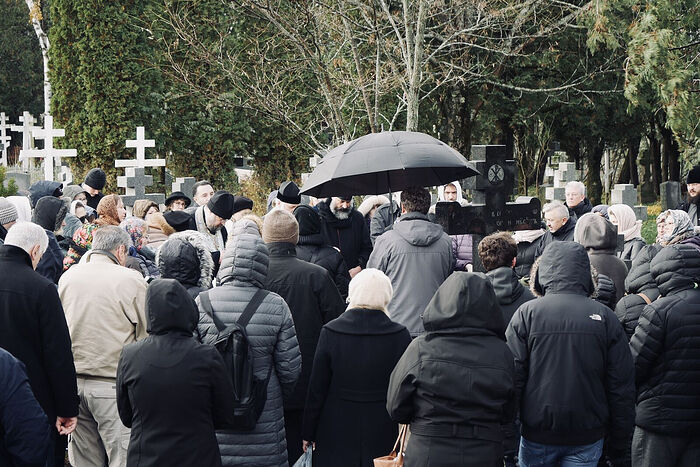 Brother Jose Pilgrimage, 2018. Photo: Holy Trinity Monastery
Brother Jose Pilgrimage, 2018. Photo: Holy Trinity Monastery
With trembling gratitude let us prayerfully remember the presence of this miraculous myrrh-streaming icon in our Church and with repentance let us pray to the Most Holy Theotokos for the forgiveness of our sins, for the establishment of peace in our Orthodox Church... During the life of Brother Jose, we got used to the Miracle; some became indifferent to this particular manifestation of God’s mercy—and in fact, in the words of Brother Jose, “you cannot get used to a miracle”.
By the grace of God, in the beginning of October 2007—the year of the restoration of canonical unity within the Russian Orthodox Church, a myrrh-streaming paper reproduction of the “Montreal-Iveron” icon mounted on wood, was revealed in the state of Hawaii.
Brother Jose and the Montreal Icon were inseparable. Together they left us. The miracle of the original icon has returned to us sinners—and the memory of Brother Jose must be returned.
***
 Brother Jose’s grave. Photo: Wikimedia commons
Brother Jose’s grave. Photo: Wikimedia commons
At 3:40 PM, the bus with pilgrims drove up to the monastery cemetery, where Brother Jose is buried. Greeting us was Bishop Luke of Syracuse, as well as fifty people from the St. Alexander Nevsky Cathedral in Howell, NJ and other US cities.
The weather was cloudy, it was drizzling, but the precipitation stopped for the duration of the panikhida. The requiem service was served by Archpriest Serge Lukianov, rector of St. Alexander Nevsky Cathedral in Howell, NJ, Priest Stephen Kaznica, and the author of these words. Praying at the panikhida was His Grace Bishop Luke, abbot of the monastery, as well as monks and seminarians. It was originally planned to bring the myrrh-streaming reproduction of the Montreal icon known as the “Hawaiian” icon, but due to the tightened COVID-related restrictions in Hawaii, this was not possible. Instead, the “Optina” Iveron Icon, presented to me in 2002 by the monks of this famous monastery, was brought to the grave of the martyr.
***
It is appropriate here to talk about the “Optina” Iveron Icon.
In March 2002, my matushka and I visited Optina Hermitage, where it was not the first time that we communicated with the monks of the holy monastery.
We were accompanied by other clergymen of the Church Abroad: Archpriest Stefan Pavlenko (California), Priest Vladimir Boikov (Australia) and Protodeacon Nicholas Triantafilidis (California).
In the skete where the elders of the Optina Hermitage lived, we met with the monastery prior, Abbot Michael (now Schema-Abbot Seraphim). He greeted us very warmly and told us that on one of the two icon boards that belonged to the murdered brother Jose, which were once given to the Optina icon painters, an exact copy of the “Montreal” Iveron Icon of the Mother of God was written. It should be said that the memory of Brother Jose is very much honored in Optina. The people of Optina consider him “theirs” in light of the fact that Jose was secretly tonsured with the name Ambrose, in honor of St. Elder Ambrose of Optina. Several icons of Brother Jose were even painted in Optina, the first of which was given to us in due time. Father Michael further said that the icon, which was kept in his cell, written on the blackboard of Brother Jose, had been streaming myrrh for three months. Having described in detail the miracle of myrrh streaming, Fr. Michael brought the icon itself from the cell so that we could venerate it. Father Michael returned to the skete-church to read the Psalter with the icon, and we went to the monastery for tea at the icon-painting workshop, where a group of monks and novices were waiting for us. We lingered on the path for a few minutes and shared our impressions of what we saw in the skete. At this time, a certain worker or pilgrim hastily approached us from the skete, who turned to us with the words: “Father Michael is urgently calling Father Victor and Matushka to church.” In complete bewilderment, we went back to the skete. Meeting us, Fr. Michael was holding in his hands the myrrh-streaming icon of the Mother of God, which he had showed us an hour earlier in the St. John the Baptist Church. Coming close to us, Fr. Michael crosswise blessed and handed me the icon. “While reading the Psalter, I felt,” said Fr. Michael “that the icon should return with you to Washington!” In parting he bowed and walked back to the skete with a quick step. Confused, I didn't know what to think, what to say. This feeling was shared by other members of our pilgrimage group.
From the skete we proceeded to the monastery with the myrrh-streaming icon of the Iveron Mother of God, and in her presence for several hours, deeply and for the benefit of the soul, communicated with the Optina monks.
At the present time, the icon is not streaming myrrh, but on its surface there are numerous traces of myrrh streaming and the fragrance of the wonderful myrrh is noticeable.
On the lower horizontal frame of the icon, it is written by the hand of the icon painter: “This icon is written on the board of the Martyr Jose Muñoz-Cortes.”
Currently, the icon is kept in the St. Elizabeth's Women’s Skete in Jordanville.
***
On Saturday, October 30, at the first panikhida at the grave of Brother Jose, we commemorated not only Br. Jose, but also his spiritual mentors: the ever-memorable Archbishop Leonty of Chile, who converted Jose to the right faith, and Schema-Archimandrite Clement, abbot of the Holy Nativity Skete on Mount Athos, the birthplace of the “Montreal” icon.
Before the commencement of the panikhida, I delivered a short sermon in which, in particular, I said that “the annual pilgrimages to the grave of Brother Jose began in 1998, on the first anniversary of his assassination, and has been held for the twenty-third time. The tortured guardian of the miraculous image often said that “you cannot get used to a miracle”. In Russia and Georgia, the veneration of Brother Jose is growing, but in our country, unfortunately, it is waning."
After the panikhida, the pilgrims venerated the “Optina” Iveron Icon, and each was anointed with holy myrrh from the “Hawaiian” Icon of the Mother of God.
At seven o’clock in the evening began a long monastery All-Night Vigil, at which not only hymns to the Resurrection were sung, but also hymnology in honor of Holy Apostle and Evangelist Luke, since on October 31, according to the new style, the memory of the Evangelist is celebrated. The divine service was officiated by Bishop Luke of Syracuse celebrating his name day, co-served by the visiting priests and a number of hieromonks.
The next day, October 31, at nine o’clock in the morning, the greeting of Bishop Luke took place in the Holy Trinity Cathedral. Concelebrating the Divine Liturgy with Bishop Luke were fourteen priests and seven deacons. The choir of monastics and seminarians sang touchingly and harmoniously under the skillful direction of Deacon Nicholas Kotar. Some pilgrims told the author of these lines that the touching monastic singing penetrated deeply into their souls and brought them tears of joy.
At the end of the Liturgy, Fr. Serge Lukianov noted in a touching sermon, that what was in common in the image of Apostle Luke and Brother Jose, was their closeness to the Mother of God and ardent spiritual zeal, which is so lacking in modern Christians, and called on everyone to imitate them.
After the liturgy and lunch, the pilgrims visited the sights of the monastery and then went to the cemetery for the second, farewell panikhida for Brother Jose. As it was drizzling light rain, the panikhida was moved to the cozy cemetery Dormition Chapel. After the panikhida, I again delivered a sermon in which I reminded those gathered of the wonderful thought of Fr. Serge Lukianov, expressed by him at the Sunday Liturgy, on the spiritual zeal of St. Luke and the Martyr Jose—that the lack of such zeal hinders the glorification of Brother Jose, and that the possible canonization of the martyr Jose largely depends on the synergy that should develop between the people of God and the hierarchy, and that he called on everyone to make efforts to make such cooperation take place.
After leaving Holy Trinity Monastery, the pilgrims visited the nearby St. Elizabeth's Women’s Skete, where they talked with the sisters. Some pilgrims managed earlier to inspect the new site and the house of the skete, where the sisters hope to move to soon.
Then there was a long journey to the American capital. On the way home, spiritually charged participants of the pilgrimage trip shared their impressions. Some have asked, what is the meaning of the return of the “Montreal” icon in the form of the “Hawaiian” myrrh-streaming icon? A possible answer: Is the Lord not directing us to the church-wide glorification of the martyr Joseph? Brother Joseph and the Montreal Icon were inseparable. Together they left us. The icon has returned; the memory of Brother Joseph must be returned, and the veneration of the martyr must find general ecclesiastical recognition.
In recent years, amazing signs have been seen at the grave of Brother Jose. Deacon Nectarios Yangson, the guardian of the Hawaiian icon, is convinced that by this the Mother of God herself glorifies her chosen one. Every year when Fr. Nectarios brought the “Hawaiian” icon to the grave of brother Jose, the holy image streamed myrrh so much, forming bubbles on the icon, and this blessed moisture poured from the icon onto the analogion cover and sometimes even to the ground. The candles on the grave burn in the pouring rain and sometimes burn down to ground level and even below ground level when the candle wicks floating in the water continue to burn. All this is captured on video recordings.
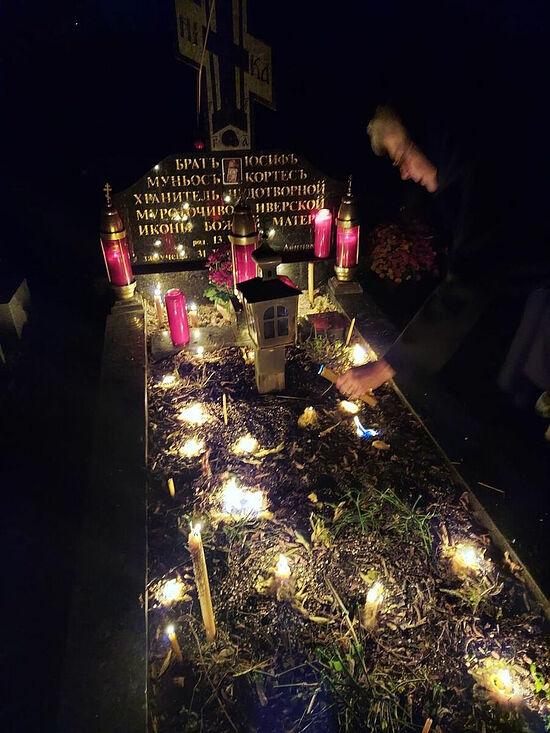 The grave of Brother Jose. Photo: Eastern American Diocese, ROCOR
The grave of Brother Jose. Photo: Eastern American Diocese, ROCOR
In 2003, on the occasion of the twentieth anniversary of the appearance of the “Montreal icon”, a book was published called, The Montreal Icon and Brother Jose, which contains 500 pages of many memories of Brother Jose and testimonies of bodily and spiritual miracles performed through the prayers of people before this marvelous icon.
Yes, Fr. Nectarios, the guardian of the “Hawaiian” icon is right—the Mother of God sends us signs to glorify Brother Jose. How many more such signs will it take to convince us, weak believers, that “God is wondrous in His saints,” and that it is time to seriously start glorifying the chosen one of the Mother of God?
Video by the Eastern American Diocese, ROCOR, 2012.
With God’s help, next year, on the twenty-fifth anniversary of the murder of the chosen one of the Mother of God and the fortieth anniversary of the appearance of the “Montreal” icon, the Cathedral of St. John the Baptist intends to conduct not only a pilgrimage to Holy Trinity Monastery and to the grave of Brother Jose, but also hold a small conference and an exhibition of personal belongings of the last martyr of the Russian Church of the twentieith century.

